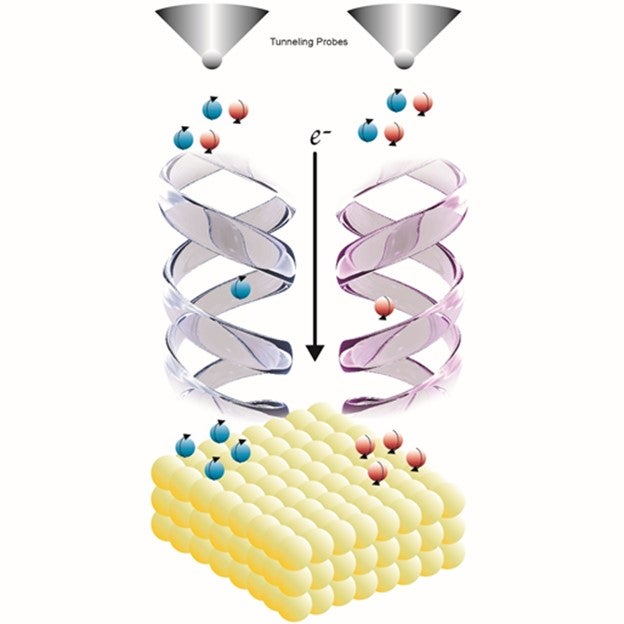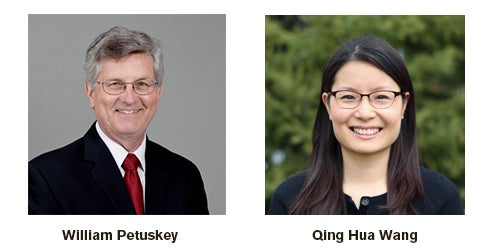ASU team accepts the NSF Quantum Leap challenge

Vladimiro Mujica, professor in the School of Molecular Sciences, is lead principal investigator of the project.
Nobel laureate and physicist Richard Feynman wrote in 1965, “I think I can safely say that nobody understands quantum mechanics.” Quantum mechanics is now much better understood, and recently in the news the race is on for researchers and companies to develop new technology with quantum mechanics that have potential to revolutionize computing and sensing devices.
A team from Arizona State University has been awarded a Conceptualization Grant from the National Science Foundation's (NSF) Quantum Leap Challenge Institute (QLCI) program to study using one of the more unusual properties of an electron — its spin — as a medium for information storage and sensing.
Through a competitive grant process, the NSF has assembled 18 research teams from around the country to tackle national strategic needs in quantum information systems and quantum sensing.
"The increasing sophistication and miniaturization of electronic technologies,” states William Petuskey, director of ASU’s Advanced Materials Initiatives, “has now advanced to the stage of manipulating and controlling matter at the scales of individual atoms and molecules. This enables designing and building complex physical devices that takes advantage of the properties of matter that are often quite different than we are familiar with at the human scales. It is a most exciting time for science and technology.”
The ASU team has proposed a general approach for controlling and manipulating electron spin for building new fundamental operational components of quantum computers and in designing chemical and physical properties in materials with extraordinary sensitivity. Of all the physical properties of an electron, spin is perhaps the most difficult to understand, since it does not have an analogy to anything in the human-scaled world. Nevertheless, it is crucially important for the stability of matter and for the existence of magnetism.
Electron spin has only one value (½) but exists in either of two orientations, “up” or “down”. When a group of electrons has more of one of these orientations than the other, they are said to be spin "polarized."
One way to control spin polarization is by transferring them across a “chiral” medium in a phenomenon known as chirality-induced spin selectivity (CISS). The ASU team’s approach involves coupling specially designed chiral molecules to specific atomic sites on solid surfaces to take advantage of the CISS effect to revolutionize the storage of information required for the next-generation quantum computers.
Chirality, also called handedness, is the key molecular feature to make this all work. Just like your left and right hands are mirror images of each other, chiral molecules can also exist in left-handed and right-handed versions that are made up of the same atoms but are mirror images of each other. In the CISS effect, electrons that transfer across a right-handed molecule generates spin polarization in the direction of electron movement, whereas transfer across left-handed molecules generates spin polarization in the opposite direction.
Transfer of an electron through molecular structures of opposite chirality generates spin polarization of opposite values
Many important biomolecules, including DNA and proteins, are chiral. Depositing oriented layers of chiral molecules on the surfaces of materials forms special interfaces with unique properties, where spins can be manipulated in a controlled way and transferred from electrons to nuclei to create novel structures for the strategically important fields of quantum storage and quantum information.
“We will study how to use chirality as a basic molecular design strategy to control the generation and transfer of spin at molecule-solid interfaces,” said Vladimiro Mujica, professor in the School of Molecular Sciences and lead principal investigator of the project.
The QLCI program is part of the NSF's Quantum Leap "Big Idea" project. The funding will be used to conceptualize the Institute for Chiral-Quantum Materials Interfaces (ICQMI) at ASU and is meant to create a national community focused on innovations for quantum computing and quantum communication. A high priority will also be given to addressing strategic national needs for workforce training in this emergent field.

Controlling spin makes possible the generation of qubits, which are the basic units of quantum computing and have important potential applications in quantum information, quantum sensing and quantum storage applications. Other potential real-world applications of this research are in the information, pharmacological and sensing industries.
"We are especially excited by the opportunity that this grant gives us to build a network of researchers who come from different disciplines from across the country. We expect to get a lot of new ideas coming from getting everyone together and talking to each other,” said Qing Hua Wang, assistant professor in the School for Engineering of Matter, Transport and Energy, and a co-principal investigator on the project.
The initial team includes researchers from ASU’s School of Molecular Sciences, Department of Physics, the Biodesign Institute and the Ira Fulton Schools of Engineering, and the University of California at Davis, and it is anticipated to grow as the project advances.
- Vladimiro Mujica, School of Molecular Sciences (PI).
- Christian Dwyer, Department of Physics (Co-PI).
- Nongjian Tao, Biodesign Institute and the School of Electrical, Computer and Energy Engineering (Co-PI).
- Sefaattin Tongay, School of Engineering for Matter, Transport and Energy (Co-PI).
- Qing Hua Wang, School of Engineering for Matter, Transport and Energy (Co-PI).
- Robert Culbertson, Department of Physics.
- Giovanna Ghirlanda, School of Molecular Sciences
- Stephen Goodnick, School of Electrical, Computer and Energy Engineering.
- William Graves, Department of Physics.
- William Petuskey, School of Molecular Sciences and the Advanced Material Initiatives.
- Antia Sanchez Botana, Department of Physics.
- Jeffery Yarger, School of Molecular Sciences.
- Hao Yan, Biodesign Institute and the School of Molecular Sciences.
- Petr Sulc, Biodesign Institute and the School of Molecular Sciences.
- Nicholas Stephanopoulos, Biodesign Institute and the School of Molecular Sciences.
- Josh Hihath, Electrical and Computer Engineering, University of California, Davis.
Professor Ian Gould contributed to this story.
More Science and technology

Science meets play: ASU researcher makes developmental science hands-on for families
On a Friday morning at the Edna Vihel Arts Center in Tempe, toddlers dip paint brushes into bright colors, decorating paper…

ASU water polo player defends the goal — and our data
Marie Rudasics is the last line of defense.Six players advance across the pool with a single objective in mind: making sure that…

Diagnosing data corruption
You are in your doctor’s office for your annual physical and you notice the change. This year, your doctor no longer has your…



